Buttock and Hip Reshaping
Buttock and Hip Reshaping in Carmel, IN
Barry L. Eppley, MD, DMD, has extensive experience in buttock augmentation and contouring and has helped many plastic surgery patients who are dissatisfied with their gluteal (buttock) area. To learn more about this procedure, please read the respective information and visit the buttocks contouring results page.
BUTTOCK AUGMENTATION
 Lack of fullness of the buttocks, which often appears as a ‘flat butt’ without a rounder shape, is the most common reason today for unhappiness with the shape of the buttock area. Some patients who undergo buttock augmentation have a congenitally small buttock, have lost a significant amount of weight after bariatric surgery, or simply desire a much rounder and fuller buttock than what they have. This concern can be treated with either fat injections or a buttock (gluteal) implant, depending upon the size and area of the buttock deficiency.
Lack of fullness of the buttocks, which often appears as a ‘flat butt’ without a rounder shape, is the most common reason today for unhappiness with the shape of the buttock area. Some patients who undergo buttock augmentation have a congenitally small buttock, have lost a significant amount of weight after bariatric surgery, or simply desire a much rounder and fuller buttock than what they have. This concern can be treated with either fat injections or a buttock (gluteal) implant, depending upon the size and area of the buttock deficiency.
Fat Injection Buttock Augmentation (Brazilian Butt Lift)
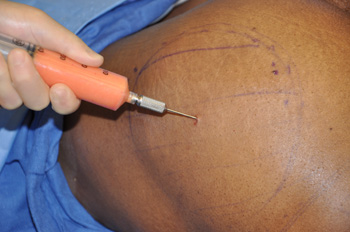 The most popular method of buttock augmentation today is through fat injections. Known more commonly as the Brazilian Butt Lift, fat is obtained by liposuction harvest, processed and then injected into the buttocks. Its appeal is two-fold. It is a natural non-implant technique that uses one’s own fat tissue and a concomitant body contouring effect is achieved by the liposuction harvest. In essence, a Brazilian Butt Lift is a two-in-one procedure.
The most popular method of buttock augmentation today is through fat injections. Known more commonly as the Brazilian Butt Lift, fat is obtained by liposuction harvest, processed and then injected into the buttocks. Its appeal is two-fold. It is a natural non-implant technique that uses one’s own fat tissue and a concomitant body contouring effect is achieved by the liposuction harvest. In essence, a Brazilian Butt Lift is a two-in-one procedure.
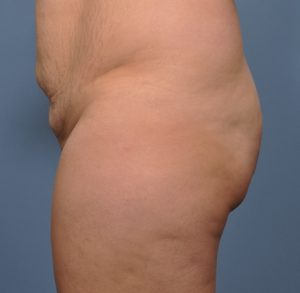
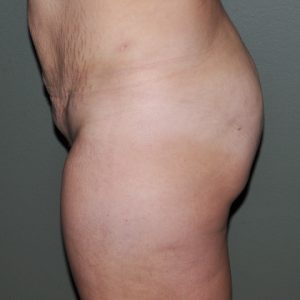 Not every patient is a candidate for a Brazilian Butt Lift as one has to have enough fat to harvest to make the procedure worthwhile. Depending upon the change in buttock size that one desires and how much fat one has to give is an important assessment before surgery. Some patients have plenty of fat to get a good buttock size change while others will have to settle for a more modest or subtle buttock shape change.There is also the unknown variable of how well the fat survives after injection. All 100% of the injected fat into the buttock never survives and, on average, 50% to 70% of what is injected may persist. The patient must accept this unknown fat survival risk.
Not every patient is a candidate for a Brazilian Butt Lift as one has to have enough fat to harvest to make the procedure worthwhile. Depending upon the change in buttock size that one desires and how much fat one has to give is an important assessment before surgery. Some patients have plenty of fat to get a good buttock size change while others will have to settle for a more modest or subtle buttock shape change.There is also the unknown variable of how well the fat survives after injection. All 100% of the injected fat into the buttock never survives and, on average, 50% to 70% of what is injected may persist. The patient must accept this unknown fat survival risk.
Candidates for Fat Injection Buttock Augmentation
A good way to think about whether one has enough fat for a fat injection buttock augmentation procedure is to use the ‘halving concept’ or the progressive 50% reduction rule. This means that there is three progressive steps in the procedure by which the amount of available fat or the fat augmentation effect gets reduced; concentration, division and survival. This means that 50% of the liposuction aspiration is lost due to pre-injection concentration (removal of blood and extraneous non-fat materials), the concentrated fat must then be divided in half between the two buttocks sides and then one can assume only 50% of the injected fat will survive. Using this concept one can see that if, for example 2,000ccs of liposuction aspirate were obtained, the final buttock augmentation volume would be only be 250cc per buttock. While this is a general concept and not absolute numbers, it is a good way to determine if undergoing the procedure is worthwhile.
Is BBL (Fat Injection Buttock Augmentation) Surgery Safe?
Since BBL surgery has become popular there have been numerous significant pulmonary complications including deaths in the U.S. and around the world. (I have never seen or experienced any such complications) What has been learned from these experiences is that where and how the fat is injected into the buttocks is critical. It is the injection of fat deep into the buttock muscle (where large veins exist) that creates the opportunity to have fat enter the blood stream. From there it can go up to the lungs (pulmonary emboli) and cause catastrophic complications. These complications can be completely avoided by only placing the fat into the subcutaneous space above the muscle which is the technique that I have always used. It has been shown that fat survival is just as good above the muscle as it is into it. This with the proper technique fat injections into then buttocks is as safe as fat injections done anywhere else on the body.
Should I Gain Weight To have BBL Surgery?
For those patients that have limited or questionable amounts of fat to harvest for fat injection buttock augmentation, a common question is whether they should gain weight to create more fat to harvest for the surgery. On this topic there are varied opinions amongst surgeons. Some surgeons advocate for such weight gain, others do not. The question is not whether weight gain creates more fat to harvest as it does. The question is what happens to the transferred fat after surgery when one returns to their presurgical weight? Some surgeons say it says while others say it does not. The biology of fat indicates that weight gain makes fat cells bigger but does not create new fat cells. (in most people and with most weight gain) Thus bigger fat cells are being transferred whose size would decrease after transfer with weight loss. But the reality is no one knows for sure just yet.
Buttock (Gluteal) Implants
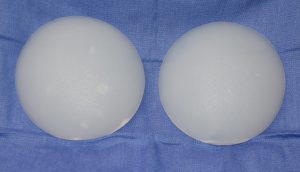
![]() For those patients who have inadequate fat for harvest, the only option is the placement of buttock implants. Unlike breast implants, buttock implants are solid, soft silicone so there is no risk of implant rupture or a silicone leak. This can be appreciated when the implant is cut in half to expose its inner composition. Buttock implants are available in different sizes and shapes to offer options for the amount of size enlargement and to some degree the shape outcome. The volume obtained from buttock implants is stable lifelong as the implants will never degrade or be absorbed. While it is true that in other countries outside of the U.S. gel-filled buttock implants are used which can rupture and may need to be replaced. But in the U.S., only solid buttock implants are FDA-approved and used.
For those patients who have inadequate fat for harvest, the only option is the placement of buttock implants. Unlike breast implants, buttock implants are solid, soft silicone so there is no risk of implant rupture or a silicone leak. This can be appreciated when the implant is cut in half to expose its inner composition. Buttock implants are available in different sizes and shapes to offer options for the amount of size enlargement and to some degree the shape outcome. The volume obtained from buttock implants is stable lifelong as the implants will never degrade or be absorbed. While it is true that in other countries outside of the U.S. gel-filled buttock implants are used which can rupture and may need to be replaced. But in the U.S., only solid buttock implants are FDA-approved and used.
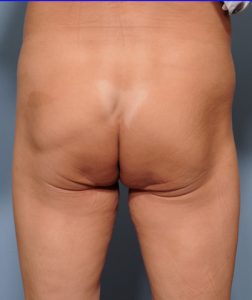
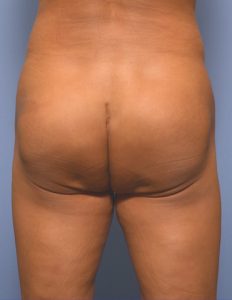 They are placed through a vertical intergluteal crease incision which does not extend higher than the very top of the intergluteal cleft. The incisions options are either a single midline vertical incision or two paired curved incisions. There are specific advantages for their use based on the planned tissue pocket for the implant.
They are placed through a vertical intergluteal crease incision which does not extend higher than the very top of the intergluteal cleft. The incisions options are either a single midline vertical incision or two paired curved incisions. There are specific advantages for their use based on the planned tissue pocket for the implant.
Buttock implants can be placed either into the muscle (intramuscular) and on top of the muscle. (subfascial) There are advantages and disadvantages to either implant location. The intramuscular location is better long-term and has less risk of implant-related complications but the recovery is significant and, most importantly, the size of implant that can be placed is more limited. (400cc or less) The subfascial buttock implant location is on top of the muscle in which larger size implants can be immediately placed but has a higher incidence of complications. (seroma, infection, implant displacement)
Candidates for Buttock Implant Augmentation
Typically candidates for buttock implants are patients that:
- Are lean with not enough fat to harvest for a successful fat injection augmentation
- Have had pior fat injections with inadequate results
While some people believe that buttock implants are only performed on females, they can placed just as effectively as in men. It is simply than the request for male buttock implants is far fewer than in women.
Custom Buttock Implants
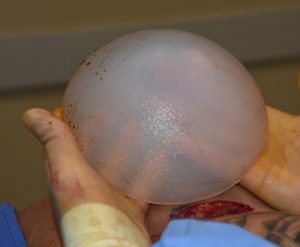
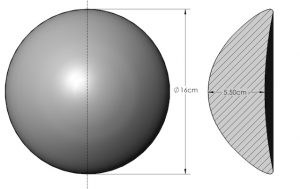 While standard sizes and styles of buttock implants will work for the vast majority of patients, there are instances where a custom buttock implant design is needed. This may be for patients that require/desire unique implant height vs base width diameters or implant volumes that are not available off-the-shelf. Custom implants are made by computer designing the desired implant dimensions which creates the final implant volume. While such custom implant designs are often for the patient who wants a higher implant volume than is commercially available, it can also be for lower implant volumes that just don’t have the desired shape or edge angle.
While standard sizes and styles of buttock implants will work for the vast majority of patients, there are instances where a custom buttock implant design is needed. This may be for patients that require/desire unique implant height vs base width diameters or implant volumes that are not available off-the-shelf. Custom implants are made by computer designing the desired implant dimensions which creates the final implant volume. While such custom implant designs are often for the patient who wants a higher implant volume than is commercially available, it can also be for lower implant volumes that just don’t have the desired shape or edge angle.
Lower Buttock Lifts/Tucks
Sagging of the buttocks or buttock ptosis occurs in two types of presentations. The first is when the infragluteal crease is in good position but there is buttock tissue hanging over it. The vertical height or length of the buttocks is fine but there is lower buttock tissue sagging over an adequately high infragluteal crease. The second type of sagging is when the infragluteal crease has dropped or is too low. This is seen as buttocks that looks too elongated with an ill-defined crease at the bottom of the buttocks. (infragluteal crease descent) Either type of buttock sagging often occurs as a result of weight loss or aging.
Contrary to marketing claims, buttock sagging is not improveable by any type of non-surgical method such as exercise, topical creams or skin tightening devices. Liposuction of the buttock tissue overhang or trying to make a defined infragluteal crease by liposuction is often ineffective and only makes the problem worse. Surgical excision and remaking the infragluteal crease is the only effective solution.
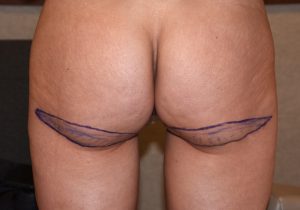 One common misconception about buttock lifts, and admittedly the use of term ‘lift’ in its name adds to this perception, is that it is done from the top part of the buttocks and the lower part is thus lifted. While such a procedure exists in bariatric plastic surgery as part of a circumferential body lift, this is the exception as to how the procedure is performed. It is performed at the bottom of the buttocks with lifting of the infragluteal fold level but not overall buttock mound. This is why it may be better to call the procedure an excisional tuck. But at the least it should be call a lower buttock lift.
One common misconception about buttock lifts, and admittedly the use of term ‘lift’ in its name adds to this perception, is that it is done from the top part of the buttocks and the lower part is thus lifted. While such a procedure exists in bariatric plastic surgery as part of a circumferential body lift, this is the exception as to how the procedure is performed. It is performed at the bottom of the buttocks with lifting of the infragluteal fold level but not overall buttock mound. This is why it may be better to call the procedure an excisional tuck. But at the least it should be call a lower buttock lift.
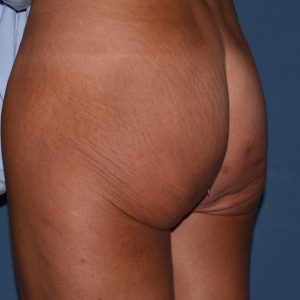
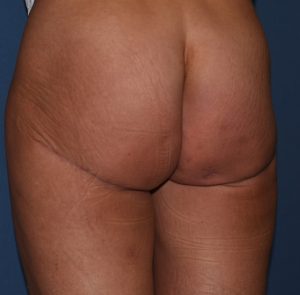 Buttock sagging can only be effectively treated by a buttock lift procedure, the removal of the excessively overhanging tissue and the creation of more defined/higher infragluteal crease. This results in a better lower buttock shape with a more pleasing transition between the buttock and the posterior upper thigh. The resultant scar lies along the buttock crease in a naturally-occurring fold location. While this operation is not for everyone, it is effective in the properly selected patient who prefers the trade-off of a near hidden scar as opposed to a tissue overhang.
Buttock sagging can only be effectively treated by a buttock lift procedure, the removal of the excessively overhanging tissue and the creation of more defined/higher infragluteal crease. This results in a better lower buttock shape with a more pleasing transition between the buttock and the posterior upper thigh. The resultant scar lies along the buttock crease in a naturally-occurring fold location. While this operation is not for everyone, it is effective in the properly selected patient who prefers the trade-off of a near hidden scar as opposed to a tissue overhang.
Composite Buttock Reshaping
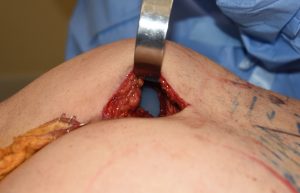
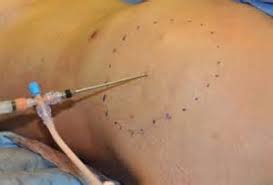 In some patients it may take a combination of buttock reshaping procedures to get the best result. This could include adding buttock volume (implants vs. fat), reducing fat around the buttocks (liposuction) or performing a tuck from below. (buttock lift) The key to mixing different types of buttock augmentation (implants and fat injections) is that the implant muscle be placed in the intramuscular location. This then permits fat to be safely injected over the buttocks into the subcutaneous space. Lower buttock lifting can be regardless of whether the implant is placed or the fat is injected.
In some patients it may take a combination of buttock reshaping procedures to get the best result. This could include adding buttock volume (implants vs. fat), reducing fat around the buttocks (liposuction) or performing a tuck from below. (buttock lift) The key to mixing different types of buttock augmentation (implants and fat injections) is that the implant muscle be placed in the intramuscular location. This then permits fat to be safely injected over the buttocks into the subcutaneous space. Lower buttock lifting can be regardless of whether the implant is placed or the fat is injected.
HIP AUGMENTATION
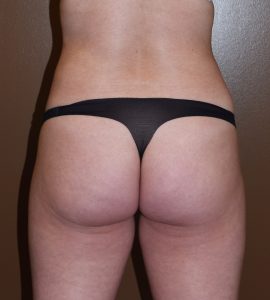 As the hips are right next to the buttocks and, from an aesthetic standpoint can be considered an extension of them, it is no surprise that the popularity of buttock augmentation surgery has led to a increased interest in hip augmentation as well. Despite their proximity, however, what works successfully for augmentation in the buttocks takes on different considerations in the hips.
As the hips are right next to the buttocks and, from an aesthetic standpoint can be considered an extension of them, it is no surprise that the popularity of buttock augmentation surgery has led to a increased interest in hip augmentation as well. Despite their proximity, however, what works successfully for augmentation in the buttocks takes on different considerations in the hips.
Around the world various synthetic injectable fillers are being used for buttock and hip augmentation, none of which are FDA approved in the U.S. for any form of body augmentation. Despite the temptation to do so adverse reactions to them are well chronicled, they can be difficult and deforming to try and remove and their long term effects are not known. Suffice it to say…buyer beware.
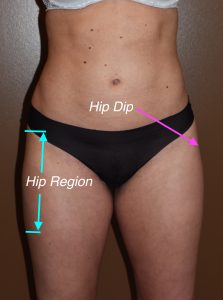 When looking at hip augmentation there are two general types, hip dips and complete hip augmentation. Hip dips are specific concave depressions right over the greater trochanter of the hip joint below the iliac crest but above most of the hip area. These typically occur in very thin females with little subcutaneous fat and often their interest is mainly to bring out the indented area. Secondly overall hip augmentation is the lateral zone from the iliac crest down almost to the mid-thigh area. What is important to realize about this area is that it is vertically longer than one thinks and that it has extensions that come anteriorly as well as posteriorly to the buttocks. In short the overall hip area is not circular in its geometric shape like the buttocks. Its surface area is elongated and its profile represents the curved transition between the anterior thighs and the posterior buttocks.
When looking at hip augmentation there are two general types, hip dips and complete hip augmentation. Hip dips are specific concave depressions right over the greater trochanter of the hip joint below the iliac crest but above most of the hip area. These typically occur in very thin females with little subcutaneous fat and often their interest is mainly to bring out the indented area. Secondly overall hip augmentation is the lateral zone from the iliac crest down almost to the mid-thigh area. What is important to realize about this area is that it is vertically longer than one thinks and that it has extensions that come anteriorly as well as posteriorly to the buttocks. In short the overall hip area is not circular in its geometric shape like the buttocks. Its surface area is elongated and its profile represents the curved transition between the anterior thighs and the posterior buttocks.
Fat Injections
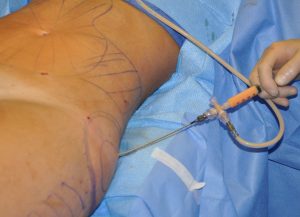 Similarly to buttock augmentation the primary method of hip augmentation is fat injections. This should always be the go to method if one has adequate fat stores to do so. Unlike the buttocks, however, fat injections do not survive as well and they have a high rate of rapid reabsorption in the hips. This does not mean it will not work for some patients but it seems like its average take percentage is low. Despite this low rate of success I still encourage patients to undergo fat injections first because of its innocuous nature compared to the placement of implants.
Similarly to buttock augmentation the primary method of hip augmentation is fat injections. This should always be the go to method if one has adequate fat stores to do so. Unlike the buttocks, however, fat injections do not survive as well and they have a high rate of rapid reabsorption in the hips. This does not mean it will not work for some patients but it seems like its average take percentage is low. Despite this low rate of success I still encourage patients to undergo fat injections first because of its innocuous nature compared to the placement of implants.
Hip Implants
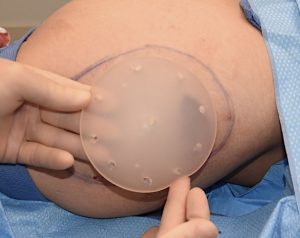
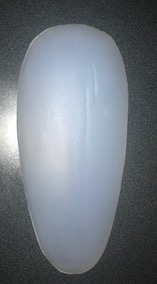 Like implants anywhere on the body, they offer an assured volume retention. But hip implant surgery is unique because it is relatively new and refinements in it are still evolving. There are two important concepts for patients to understand about this surgery. First, there are no performed off-the-shelf hip implants. That alone speaks volume about the limited history of hip implantation. Often standard body implants not specifically made for the hips are used with variable aesthetic success. For the hip dips small low profile buttock implants may be successful as that area is more circular in shape. For general hip augmentation more elongated large calf implants can be used that can be effective for some patients.
Like implants anywhere on the body, they offer an assured volume retention. But hip implant surgery is unique because it is relatively new and refinements in it are still evolving. There are two important concepts for patients to understand about this surgery. First, there are no performed off-the-shelf hip implants. That alone speaks volume about the limited history of hip implantation. Often standard body implants not specifically made for the hips are used with variable aesthetic success. For the hip dips small low profile buttock implants may be successful as that area is more circular in shape. For general hip augmentation more elongated large calf implants can be used that can be effective for some patients.
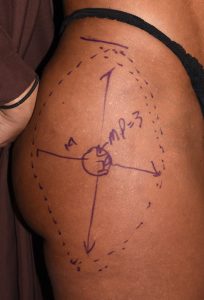
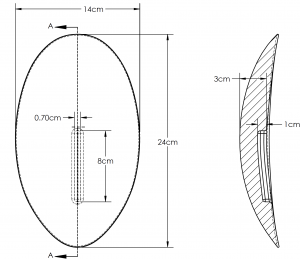 Ideally, however, the best hip implants are custom made for each patient based on external measurements. This allows the desired amount of hip area to be covered and the exact desired location of the maximal projected area to be located on the implant’s shape.
Ideally, however, the best hip implants are custom made for each patient based on external measurements. This allows the desired amount of hip area to be covered and the exact desired location of the maximal projected area to be located on the implant’s shape.
The pocket for hip implants is unique from all other body implants. As a general guideline it is always best to have an implant under the thickest or deepest tissue pocket possible. (submuscular, intramuscular or subfascial) But in the hip area this would mean being under the TFL fascia which would place the implant down at the mid-thigh level creating a too low hip augmentation effect. As a result the best aesthetic location for hip implants is down at the deep subcutaneous level on top of the TFL fascia. Such a pocket location increases the risks of postoperative flood collections (seroma) and potential implant edge visibility is very thin patients.
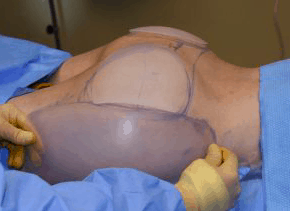 Because of the pocket location for hip implants this has an important implication for indwelling buttock implants or considering combining buttock and hip implant surgery. To have hip implants placed the buttock implants ideally should be in an intramuscular location. This will ensure that the two tissue pockets do not have the risk of connecting or one implantation site adversely affecting the other.
Because of the pocket location for hip implants this has an important implication for indwelling buttock implants or considering combining buttock and hip implant surgery. To have hip implants placed the buttock implants ideally should be in an intramuscular location. This will ensure that the two tissue pockets do not have the risk of connecting or one implantation site adversely affecting the other.
Buttocks and Hip Reshaping – Before Surgery
An examination is needed to determine the size and shape of the buttocks and which procedure, (Buttock lift, buttock implants or fat injections, would be most effective in improving its shape of the buttocks. It is important that the patient have a clear understanding of the location and size of the resultant scar if a buttock lift is chosen. In buttock implants, measurements are taken to determine the size and style of buttock implant to be used. When choosing an implant, the risk of infection and shifting of the implant position after surgery must be addressed. With fat injections to the buttocks, how much fat will survive is unpredictable and one must accept that overcorrection is initially needed or multiple fat injections sessions may be required. In some cases, combination(s) of implants, lifts, or fat injections may be used to achieve the best buttock shape and size.
Buttocks and Hip Reshaping – Operation
A buttock lift is almost always performed on both sides simultaneously under general anesthesia as an outpatient Procedure. The area is marked before surgery in the standing position. The overhang is elliptically cut out and closed with dissolvable sutures placed under the skin. The incisional area is usually taped after surgery for support.
Buttock augmentation through implants or fat injections is also performed under general anesthesia as an outpatient procedure. Buttock implants are placed through a single vertical incision in the intergluteal fold between the upper buttocks, and the small incision is closed with dissolvable sutures. A compression girdle is placed after the operation is completed.
Buttock augmentation with fat injections is an outpatient procedure done under general anesthesia also. Fat is harvested, usually from the abdomen and flanks, processed for concentration, and then injected into the desired buttock areas. Usually 250cc – 500cc is injected per each surgery session. Usually as much fat is injected as possible based on how much the patient has to give.
Buttocks and Hip Reshaping – After Surgery
In buttock lifts, the most important postoperative care concern is to limit the amount of extending sitting, bending over, or flexion of the hips that places strain (stretching) on the incisions. Standing or laying down keeps the junction between the legs and buttocks un-stretched and this should be done as much as possible in the first several weeks after surgery. One may return to completely normal physical activities within two to three weeks. There is very little discomfort associated with this procedure other than the feeling of tightness in the area after surgery.
In buttock enlargement with implants or fat injections, sitting will be uncomfortable after surgery. While there is no harm from sitting, it will not be completely comfortable for several weeks after surgery. One may resume physical activity as soon after surgery as one desires.

North Meridian Medical Building
Address:
12188-A North Meridian St.
Suite 310
Carmel, IN 46032
Contact Us:
Phone: (317) 706-4444
WhatsApp: (317) 941-8237
